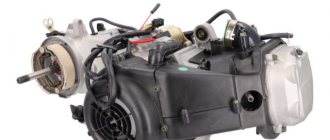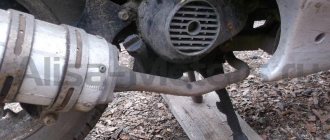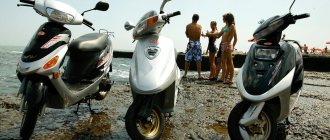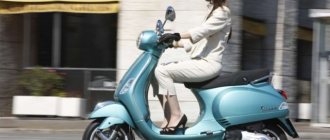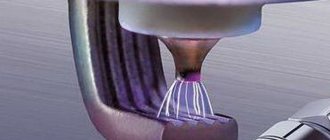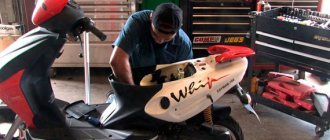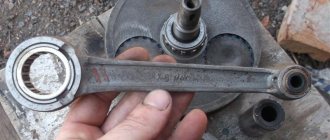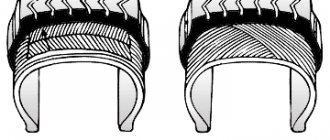How to avoid flooding spark plugs with gasoline?
The most important criterion is to maintain the battery charge and the functionality of the starter. For this, sufficient conditions are created for the scooter to start even on the frostiest morning. In addition, you should fill in high-quality oil and use high-quality gasoline with a sufficient octane number, as specified in the operating manual of the purchased scooter. As a preventative measure, it is worth cleaning and adjusting the injector nozzles.
People's Council
To prevent the spark plug from flooding with gasoline during the cold season, you should occasionally “spin” your scooter to maximum and move at a speed slightly above average, thus increasing the load on the scooter’s engine at high speeds, due to which self-cleaning of carbon deposits and excess in the combustion chamber occurs.
By fulfilling all these basic requirements, you can not only eliminate problems associated with filling spark plugs with gasoline, but also increase the service life of your scooter’s engine significantly. By following all the above instructions, you will not have to contact a car service center again for expensive service.
Experienced vehicle owners know that in the cold season, for some reason, sometimes the scooter does not start. Some people find themselves in such an unpleasant situation in the summer, but much less often. The problem can have many causes, but the most common is a flooded spark plug.
This can happen regardless of the fuel injection system, injector or carburetor, installed on your scooter. The design of the spark plug and methods for troubleshooting the problem do not change significantly.
In the case of an injector, the fuel supply is regulated by an electronic control unit. Cold air has more oxygen. Realizing this, the ECU increases the supply of gasoline. If the spark in the plug is not strong enough, unignited fuel will remain on the spark plug electrodes. Then it will no longer be possible to start an iron horse.
Replacing spark plugs on a motorcycle or car
1. In most cases, replacing spark plugs on a motorcycle or car requires a special spark plug head (with an elastic rubber insert inside or, even better, a magnetic spark plug head) complete with a ratchet drive and a device for checking and adjusting the interelectrode gaps. To safely disconnect explosive tips (“ armor ”) of wires from spark plug , a special tool is also available, although its use is not strictly necessary. Using a torque wrench will allow you to achieve the correct torque for the spark plugs in the cylinders of a motorcycle engine . 2. It is best to keep a set of replacement spark plugs with a correctly adjusted interelectrode gap your motorcycle / car When purchasing new spark plugs, make sure that they meet the parameters of your motorcycle / car . The necessary information is given in the specifications of the motorcycle / car in the book or manual. 3. Proceed to remove the spark plugs only after the engine has completely cooled down. To avoid wasting time, take advantage of the pause to check the condition of the replacement kit. Carefully inspect the new spark plugs ; if the slightest cracks are detected in the insulator, the corresponding spark plug should be rejected. Measure the size of the interelectrode gaps of the new set (see below).
| 4. The interelectrode gap of the spark plug is checked by inserting the appropriate meter probe into it and must meet the requirements given in the manual (technical book for the motorcycle). The probe of the required thickness should slide with slight resistance between the side and center spark plug electrodes. The gap can be adjusted using a special device, usually included in the meter - bend the side electrode of the spark plug accordingly. 5. If the side electrode is not positioned exactly above the center electrode, adjust its position accordingly. Make sure there are no cracks or other damage to the porcelain spark plug insulator. The presence of any kind of defects in the insulator is unacceptable. | Adjusting the interelectrode gap on spark plugs |
Removing/replacing spark plugs on a motorcycle
By the appearance of the spark plugs, we can draw conclusions about the operation of the spark plugs, the control of mixture quality and the condition of the motorcycle engine (pistons, piston rings, etc.). The plate below will help any motorcyclist or car enthusiast determine the condition of the spark plug, and therefore the condition of the motorcycle/car engine.
Carbon deposits on spark plug electrodes
The procedure for performing work on replacing spark plugs |
| Symptoms: The presence of soot indicates an over-rich fuel-air mixture or weak spark intensity. Causes misfires, makes starting difficult and leads to instability of the motorcycle engine . Recommendations: Check if the air cleaner is clogged, if the fuel level in the float chamber is too high, if the air damper is stuck and if the contacts are too worn. Try using spark plugs with a longer insulator, which increases resistance to fouling. |
Oiling the spark plug
| Symptoms: Oiling of the spark plug is caused by wear of the oil seals. Oil enters the combustion chamber through worn valve guides or piston rings. Causes misfires, makes starting difficult and leads to engine instability. Recommendations: Carry out mechanical restoration work and replace the spark plugs. |
Normal spark plug condition
| Symptoms: Gray-brown color and slight wear of the electrodes. The glow number of spark plugs corresponds to the type of engine and its general condition. Recommendations: When replacing spark plugs, install spark plugs of the same type. |
Ash formation on spark plug electrodes
| Symptoms: Soft brownish deposits on one or both spark plug electrodes. The source of their formation is the additives used for oil and/or fuel. Excessive buildup can cause the electrodes to insulate and cause misfire and rough running of the engine under acceleration. Recommendations: If deposits accumulate quickly, change the oil seals, which will prevent oil from entering the combustion chambers. Try changing the brand of fuel. |
Overheating of spark plugs
| Symptoms: Porous, white insulator, electrode erosion and absence of any deposits. Leads to a reduction in spark plug life. Recommendations: Check whether the heat number of the installed spark plugs meets the specifications, whether the ignition timing is set correctly, whether the fuel-air mixture is supplied too lean, whether there are any vacuum leaks in the intake manifold and whether the valves are stuck. Also check the coolant level and whether the radiator is clogged. |
Spark plug wear
| Symptoms: Rounded electrodes with slight accumulation of deposits at the working end. The color is normal. Leads to difficulty starting the engine in cold wet weather and increased fuel consumption. Recommendations: Replace the spark plugs with new ones of the same type. |
Ignition too early for spark plug
| Symptoms: melted. The insulator is white, but may be dirty due to misfires or foreign particles entering the combustion chambers. May cause engine failure. Recommendations: Check the heat number of the installed spark plugs, the ignition timing, the quality of the mixture (is it too lean), whether the cooling system is clogged and whether the lubrication system is functioning normally. |
Ignition too early (consequences)
| Symptoms: Heavily melted. The insulator is white, but may be dirty due to misfires or foreign particles entering the combustion chambers. May cause engine failure. Recommendations: Check the heat number of the installed spark plugs, the ignition timing, the quality of the mixture (is it too lean), whether the cooling system is clogged and whether the lubrication system is functioning normally. |
Detonation
| Symptoms: Insulators may become chipped or cracked. Damage to the insulator can also be caused by inaccurate spark plug gap adjustment techniques. May cause damage to pistons. |
Splashing
| Symptoms: After misfiring for an extended period of time, deposits may loosen while the combustion chamber remains at operating temperature. At high speeds, deposits flake off the piston and stick to the hot insulator, causing a misfire. Recommendations: Replace the spark plugs or clean and replace the old ones. |
Electrically conductive gloss
| Symptoms: The insulator has a yellowish color and a polished appearance. Indicates a sudden increase in temperature in the combustion chambers during sudden acceleration. In this case, ordinary deposits are melted, taking on the appearance of a varnish coating. Leads to misfires at high speeds. Recommendations: Change the spark plugs (colder ones, while maintaining your driving style). |
Mechanical damage to the spark plug
| Symptoms: May be caused by foreign material entering the combustion chamber or may occur when the piston hits a spark plug that is too long. Lead to failure of the cylinder and damage to the piston. Recommendations: Remove foreign particles from the engine and/or replace |
Short circuit of spark plug electrodes
| Symptoms: Waste combustion products enter the interelectrode space. Solid deposits accumulate, forming a bridge between the electrodes. Leads to ignition failure in the cylinder. Recommendations: Remove deposits from the interelectrode space. |
Start the engine
Just yesterday, the scooter or moped was working normally, but in the morning its engine simply does not start. Probably the reason is a flooded candle. You can, following the instructions, take out and dry the candles, but if you are short on time, you should try the traditional method.
To use it, you first need to let the scooter stand for a little time - about 5 minutes. Then you should completely unscrew the gas handle and turn the starter. Continue for about fifteen seconds. At this time, there will be no fuel supply to the chamber, so it will be purged with air. Most likely, such a simple operation will be enough and the engine will start. This should work on both 2t and 4t scooters.
If the iron horse does not start, you will have to use another method. To implement it, you will need a little time, patience and a spark plug. First, you should unscrew the spark plug and make sure that it is the problem. It can be cleaned with a brush and then dried with a hairdryer. However, any heat source will do: hotplate, oven or gas burner. Next, it is recommended to blow out the cylinder in the same way as with the traditional method. Then insert the candle back. Now the engine just has to start. If this does not happen now, you will have to replace the spark plugs and carry out diagnostics.
After the engine has successfully started, there is a temptation to leave everything as is. However, it is recommended to determine what the problem was. Regardless of whether the spark plug on a moped or scooter is flooded, most likely some parts require cleaning or replacement. But even if the reason is only that the vehicle is not new, there are ways to avoid a flooded spark plug in the future.
How to change?
We take it, buy it, ask someone for a special spark plug wrench. We put the key on the spark plug, insert a screwdriver into the key and turn the spark plug out. After unscrewing the spark plug - carefully so as not to accidentally drop it into the cooling casing - remove it along with the key
As necessary, we insert a new spark plug into the key and very carefully and slowly screw it into place. When you wrap the candle, do not apply much force to it, and if you feel that at the very beginning the candle is wrapped tightly, then you have not hit the thread: unscrew it and try to screw it again.
If the candle went easily, wrap it all the way and pull it slightly. It is not advisable to tighten the candles too much; it will be enough to tighten them a little and this will be quite enough.
Fills a candle on a scooter
If your scooter, for no apparent reason, starts up poorly and constantly fills the spark plug, then perhaps the cause of the malfunction lies in a poorly tuned carburetor. To fix everything, you need to re-adjust the carburetor. Let's look at how this can be done using the example of the Honda Dio scooter.
I would like to note that the carburetors on other scooters have a similar structure and are configured in a similar way.
Correct carburetor adjustments should only be made on a hot engine. If you make adjustments on a cold engine, the auxiliary fuel supply valve will not have time to close and will interfere, as a result the work will be done incorrectly. It is best to adjust the carburetor after 10-15 minutes of engine operation.
So you should make sure that the air filter is clean and, if necessary, clean it or replace it with a new one. It is also better to install a new spark plug. Be sure to clean and purge the carburetor parts; without this, proper tuning of the carburetor is impossible.
Carburetor adjustment
Now you can begin adjusting the carburetor itself. Let's start with the needle in the air damper. It has 3 grooves, the locking ring should be installed in the middle groove. The mixture quality adjustment screw must be fully tightened and then unscrewed 0.5 or 1 turn. Now you need to start the engine. If the engine speed is too high, then use the idle speed adjustment screw to reduce it to normal. If they are small, then we increase them to normal.
Read also: black candle on a scooter
Now you can take a ride. If the engine begins to “stutter” when accelerating, then the mixture quality screw must be tightened a quarter turn. After this we also set up idle operation.
If fuel consumption has increased, then you need to lower the needle to the last mark and repeat the setting as indicated above. If, on the contrary, the scooter does not have enough fuel, there are failures in operation, then we raise the needle - set it to the last lower division and again adjust the carburetor.
The correct carburetor setting can be determined by the color of the carbon deposits on the spark plugs. If there is little of it and it is brownish in color, then everything is configured correctly. If it is velvet black, then there is obvious excessive fuel consumption.
A properly adjusted carburetor will not overfill or flood the spark plug. The engine will run smoothly without failure.
Spark plugs for scooters with two-stroke engines
To use this or that type of spark plug, understand the engine model installed on the scooter.
Older models had a simplified two-stroke engine. Domestic motors had something similar. The displacement of these engines is very small. Smaller than the modern standard of fifty cubic meters. The cylinder has a motorcycle shape, but is smaller in size, comparable to a chainsaw or trimmer. An ordinary motorcycle spark plug of standard diameter is screwed into such a cylinder. The base of these candles is small, because the two-stroke type of engine uses a mixture of gasoline with a low octane number, for example seventy-six or eighty, and a special two-stroke burnable oil. You can also use a candle with a long base - “Zhiguli”. Just before use, screw several o-rings onto the base, about four or five. Such spark plugs produce a spark of greater power, as they are intended for use in cars.
On newer two-stroke scooter models, use smaller spark plugs. They appeared not so long ago, specifically for such engines. The diameter of the candle is much smaller than the standard one, the base is elongated. An important feature of such candles is that it is impossible for them, as in the previous version, to find an alternative. The size of the thread in the cylinder allows the use of only such candles and no more.
The positive side of this situation is the impossibility of making a mistake when choosing a spark plug; the negative side is that the low level of assortment does not allow upgrading the vehicle. It will only be available after replacing the piston component of the engine. Fuel such scooters with gasoline with an octane level above eighty. Observe the proportions of adding oil to gasoline, otherwise soot will be deposited on the spark plug.
Performance indicators
Vespa scooter models are distinguished by high performance indicators. All models are equipped with a reinforced metal body, as well as high-quality brakes. The tank holds enough gasoline for several days of intense city driving and is very economical.
Engine
Vespa scooter models are constantly updated with better and more reliable engines. Depending on the model, the vehicle is equipped with a single-cylinder 2-stroke or 4-stroke engine with an electric injection system. In the production of Vespa scooters, engines have different displacements - from 100 cm³ to 300 cm³.
Chassis and brakes
Most often, Italian scooter models are equipped with front disc brakes and rear drum brakes. For better safety, the most powerful scooter models are equipped with an ABS system. A distinctive feature of the Vespa is the monoshock absorber at the front, which adds to the smooth ride.
What to do if the candles are flooded with gasoline
There are 2 options to solve the problem. As a rule, a “reasonable” operating manual says: if the injector spark plugs are filled with fuel, you need to unscrew them and dry them. With the spark plugs removed, crank the starter for 10-15 seconds. Put the spark plugs back in and start the engine.
Reliable folk method. If you have filled your spark plugs with gasoline, before unscrewing and drying them, try starting the engine using the following method: purge mode.
The gas handle is turned all the way to the floor. Use the starter to turn the engine for 10-12 seconds, then release the gas handle. The engine should start. The fact is that in this way, when you close the fuel supply, you blow air through the spark plug.
If the engine does not start, then try to dry the spark plugs. Spark plugs for an injector are no different from an engine with a carburetor. Therefore, we again use the “old” method: we unscrew the candles, clean them of carbon deposits with a brush, dry them with a hairdryer, or on a gas stove or in the oven. We control the gap and screw the spark plugs into place. The motor should start.
For used scooters, professional advice is to clean the spark plugs more often, or, more correctly, change them.
If the spark plugs continue to be constantly filled with gasoline, it is necessary to carry out diagnostics of the spark plugs for quality of spark supply, cleanliness of injectors, spark output from the ignition coil, Hall sensor.
Why does a spark plug on a scooter flood and what should I do?
Why does a spark plug on a scooter flood and what should I do?
Scooters often encounter this problem when the spark plug is flooded, when yesterday their favorite mode of transport started and drove well, but today they just can’t start it.
When you unscrew the spark plug, it turns out that it is wet with gasoline.
The main reason why a spark plug is flooded with fuel can be called the quality of the spark plug itself. Try changing it.
The second reason is the quality of the fuel. As we know, it is not always possible to buy high-quality fuel at a gas station, and therefore impurities cause contamination of the spark plug and, in the end, it stops producing a spark of the required charge.
Another important reason is a weakly charged battery. Charge the battery or replace it with a new one.
Poor quality oil, which is used in scooters, can also cause contamination of the spark plug and therefore fill it with gasoline.
Don't forget about the quality of the high voltage cable. If it is broken, there will be a weak spark or no spark at all and the spark plug will be filled with gasoline.
If the scooter does not start, there can be many reasons, but quite often it happens because the spark plug is filled with gasoline. An unscrewed wet spark plug will confirm this.
First you need to unscrew the spark plug and dry it, put it in place and try to start the scooter. If it does not start, and the unscrewed spark plug is wet again, then the reason is that the spark plug is flooded. Now we need to understand why this happens.
It is necessary to check the position of the carburetor, as it may be tilted, which leads to gasoline leaking out and hitting the filter.
It is also necessary to check the vacuum valve (is it leaking?)
It often helps if you put a new, good candle.
The quality of the fuel mixture also plays a role. A low-quality fuel mixture will ignite poorly and splash the spark plug.
It is best to contact a service station. they will sort out your problem there. Well, if you want to save money, do the repairs yourself. It is quite possible that the spark plug is wet from gasoline. The easiest way is to change the spark plug itself or adjust the carburetor.
you will need to adjust the carburetor! To do this, take a screwdriver and tighten all the jacks, then unscrew them one and a half to two turns! then watch the candle! if the spark plug is light, that’s normal; if it’s black, you’ll need to tighten up the gas supply or give more air!
CC 2022 All rights reserved. Copying prohibited. woprosi.ru
Spark plugs and heat rating
Which spark plug marking should be used for a specific model? These are the questions most scooter riders ask. In today's article you can find all the information about the most popular models of Italian scooters traveling around our country. It is the Italian models that still remain a mystery to owners.
There is very little information on the Internet for these scooters, as a result of which many owners buy consumables at random, which often leads to breakdowns and improper operation of the scooter as a whole. The spark plug gap plays an important role in spark formation, ignition of the mixture, and operation of the scooter throughout the entire speed range.
The most popular spark plugs that have proven themselves over the years are NGK, Champin, Denso. You can buy them at any scooter and car parts store, the main thing is not to get a fake.
: Spark plugs and heat rating
We have already described how to distinguish fake candles from the original in one of our articles. The table below shows the main models of scooters from the Piaggio concern, several brands owned by the concern, and Vespa scooters.
For each scooter model you will find a recommended spark plug indicating the marking and the required gap.
Strictly observe the clearances and use only original consumables of the name indicated in the table. Name required.
Spark plug clogged
Subscribe to site updates:. Didn't find the answer to your question?
Ask your question directly in the comment box. To receive qualified help, describe your situation in detail, following the spelling rules.
Leave a comment Click here to cancel reply. Cancel commenting. Still have questions? Register on the forum. Everything about repair, maintenance, tuning of scooters, mopeds and light motorcycles. Welcome to our club.
We discuss on the forum:. Re: Honda Topic Pro – repair and maintenance Dec 17 – Honda Zoomer, rear shock absorber replacement and problem with. More about Scooter-remont. Questions and answers Instructions and operating manuals for scooters, manuals, diagrams Malfunctions and diagnostics of scooters News of scooters and mopeds Reviews and tests of scooters European scooters Chinese scooters Taiwanese scooters Japanese scooters Scooter maintenance Useful information for owners of scooters and mopeds Do-it-yourself scooter repair Tips for using a scooter Scooter tuning Scooter design.
Do-it-yourself relay-regulator for a scooter Version 2 - additions, calculations, measurements, graphs Version 1 - conclusions based on practical analysis Scooter repair instructions, manuals, diagrams. Maintenance, operation and repair manuals for all models of scooters and mopeds, instructions, electrical diagrams, literature.
Your questions about the repair of scooters, mopeds and scooters. Answers to the most popular questions about the repair and maintenance of scooters and mopeds, more consultations from professionals. Discussion of breakdowns and malfunctions of motorcycle equipment. On the site forum you will find solutions to all problems with scooters and mopeds. All your questions about scooter repair, tuning and maintenance will be answered here.
Model range: description, technical characteristics and prices
Below we will present a more detailed description of the Vespa scooter model range.
Vespa LX 50
The Vespa 50 scooter is a comfortable and reliable option for a lover of retro models. The engine has a volume of 49.4 cm³ and a power of 4.2 hp. will ensure reliable operation of the model. Maximum speed – 45 km/h, fuel tank volume – 8.6 liters. The model weighs only 96 kg. The average cost of the model is 138,000 rubles.
Vespa S 50
This model has a 50 cm³ engine similar to the previous model. The electronic ignition system allows you to quickly gain the required speed. The centrifuge-type automatic transmission with belt drive will help you easily drive the vehicle. Fuel tank volume is 8 liters, power is only 4 hp. The average cost is 140,000 rubles. Below is a review of the Vespa s50 scooter.
Vespa LX 125
The Italian Vespa lx 125 scooter, whose price reaches 170,000 rubles, is considered a faster model. Maximum power reaches 91 km/h. The four-stroke single-cylinder engine with an air-cooling system makes it convenient to move around the city. Fuel consumption is 4.4 liters per 100 km.
Italian scooter Vespa lx 125Vespa S 125 ie
A comfortable scooter for 275,000 rubles. Luggage racks and a seat hook allow you to take on your daily commute. The small 50cc air-cooled engine with electronic injection gets the job done reliably.
Vespa LXV 125 ie
Model with an engine displacement of 124 cm³. The air cooling system and electric starter allow you to use the vehicle conveniently and safely. The model develops power by 10.7 hp. at 8250 rpm. The cost of a new scooter is 186,000 rubles.
Vespa GTS 125
The Vespa GTS 125 scooter has a CVT gearbox. A 7 liter fuel tank is sufficient for a 124 cm³ engine. Hydraulic disc brakes front and rear ensure safe movement on the most difficult roads. The maximum speed of this Italian scooter is 95 km/h. The cost of the model reaches 390,000 rubles.
Vespa GTS Super 125 ie
A stylish and easy-to-use model with a 4-stroke, 4-valve, 124 cm³ engine. The power of the model is 11 kW at 9,750 rpm. The maximum speed of the model is 103 km/h. Increased fuel tank volume by 9.5 liters. The price of the model is 420,000 rubles.
Model Vespa GTS Super 125 ie
Vespa LX 150
Scooter with a single-cylinder four-stroke engine of 150 cm³. Reliable aluminum wheels, front tire – 110/70 R11, rear – 120/70 R10. High-quality front disc brakes and rear drum brakes allow you to safely ride the Vespa LX 150 scooter even on the most difficult roads. The weight of the scooter is 102 kg, the average cost is 200,000 rubles.
Vespa S 150 ie
The stylish Vespa S 150ie scooter began production in 2008. Convenient, high-quality model with economical fuel consumption - 3.1 liters per 100 km. The engine capacity reaches 150 cm³. As in other models, the presence of front hydraulic wheels, as well as a rear drum. There is a comfortable seat for the driver and passenger, as well as a standard luggage bag. Cost – 250,000 rubles.
Vespa GTV 250 ie
A sophisticated scooter model with a steel frame and hydraulic disc brakes at the front and rear. The engine displacement of 244 cm³ allows you to achieve a power of 22 hp. The larger 9.2-liter fuel tank allows for long trips. The cost of the scooter is 277,000 rubles.
Scooter model Vespa GTV 250 ie
Vespa GTS 250ie
The 2010 model has a 244 cm³ engine and similar characteristics to the previous model. The scooter weighs 151 kg. The vehicle is suitable for active people who want to use Vespa not only for a quiet ride, but also for sports trips.
Vespa GTS Super 300ie
A sporty, powerful model with an engine capacity of 278 cm³. The liquid cooling system prevents the engine from overheating during long driving. The frame is made of high-strength metal, with reinforcements welded to the body. The Vespa GTS Super 300ie scooter is capable of reaching a top speed of 130 km/h. Fuel consumption is 3 liters per 100 km. The price of the model is 448,000 rubles.
Vespa GTV Via
Sports model weighing 146 kg. A distinctive feature is the powerful 278 cc engine with liquid cooling and electronic injection. Maximum power is 22 hp. at 7500 rpm. Stylish design, comfortable leather seat, and 12-inch wheels with chrome inserts. The cost of the model is 480,000 rubles.
https://youtube.com/watch?v=KgwboNcRRDs
Troubleshooting
First of all, you need to understand what it is
Even if the cause has been found, it is worth paying attention to other possible problems, since they may be related. Required:
Check battery charge. In the cold season it is worth keeping it charged, since the power of the spark indirectly depends on this
This is especially important for older vehicles, since their battery life is already partially exhausted. Make sure the quality of the fuel used. You should always buy gasoline only from reliable gas stations.
With poor nutrition, the iron horse can fail at the most inopportune moment. It doesn’t matter whether the trip is planned on an Alpha moped or a Symphony scooter. Choose the right oil. Its quality and viscosity also matter. In cold weather, winter oil should be used. If the spark plug on a 4t scooter is flooded, be sure to check that the valves are adjusted correctly. If this is not the case, fuel may enter the chamber at the wrong time and not ignite. Check if the air filter is dirty. It may require cleaning or even replacement.
If a carburetor is used as a fuel supply system, its mixture quality screw should be adjusted. Make sure the spark plug is working optimally. If necessary, adjust the gap between the electrodes, replace the spark plug or ignition coil.
Spark plugs for scooters with four-stroke engines
For four-stroke engines, choose a spark plug similar to the previous one, only with an even larger base.
To use such a scooter there is no need to fill it with a combustible mixture. It runs on pure gasoline. There should be only one sealing ring on such a spark plug. The same spark plug is used not only on scooters, but also on some small Japanese motorcycles. Their engine capacity is on average from one hundred twenty-five to two hundred cubic meters. The efficiency of such candles is higher, but the service life is much shorter. With regular use of the vehicle, the central electrode on the spark plug burns out within a year and a half.
Why does the spark plug on a scooter burn out?
Every scooter owner has probably found himself in this situation: he came home on a scooter, parked it in the garage overnight, and in the morning he was faced with a problem starting it.
Of course, there can be many reasons why a scooter does not start, however, the most common of them is flooding the spark plug with fuel.
In addition, it does not matter at all what kind of fuel injection system you have - carburetor type or injection; in any case, the spark plugs are filled with gasoline
Most often, filling spark plugs with gasoline occurs when the temperature drops below zero and only with rare exceptions on warm summer days. Let's try to figure out why the spark plug in the injector fills with gasoline and what to do if such a problem arises. In addition, we will try to provide advice so that you can avoid getting into such an unpleasant situation.
Installing spark plugs in a motorcycle or car engine
| 1. Before installing new spark plugs , lightly coat the threads with anti-seize sealant. Manually thread one of the new spark plugs into the appropriate hole in the motorcycle engine . After making sure that the spark plug is not skewed in the thread, tighten it with the required force (if you have a torque wrench ). To facilitate the procedure of fitting the spark plug, pull a piece of flexible fuel hose onto its shank. This eliminates the possibility of thread breakage, since the slightest biting of the hose will simply begin to turn. | |
| 2. Using rotational and translational movements, place the tip of the explosive wire on the spark plug . | |
